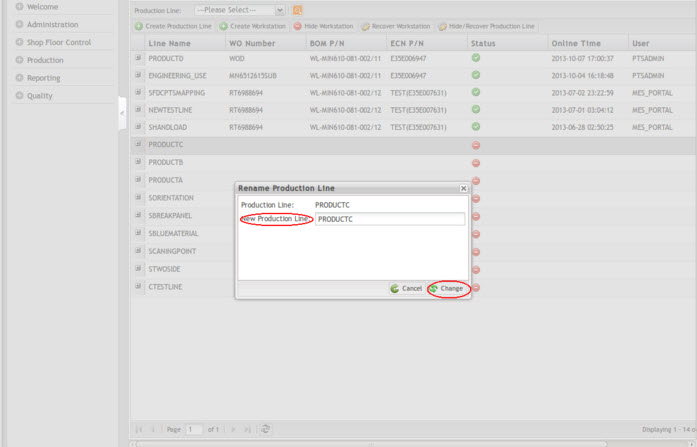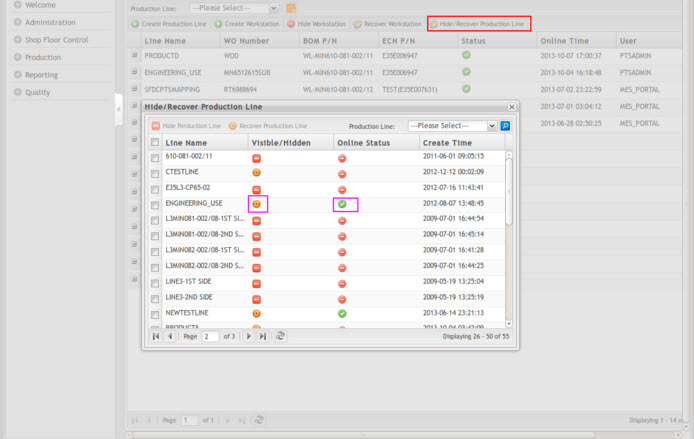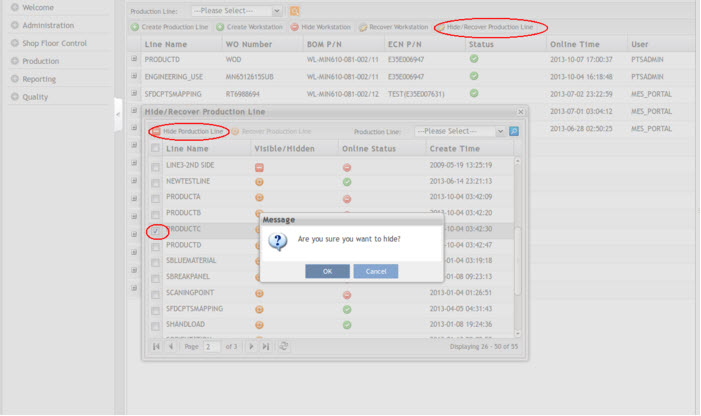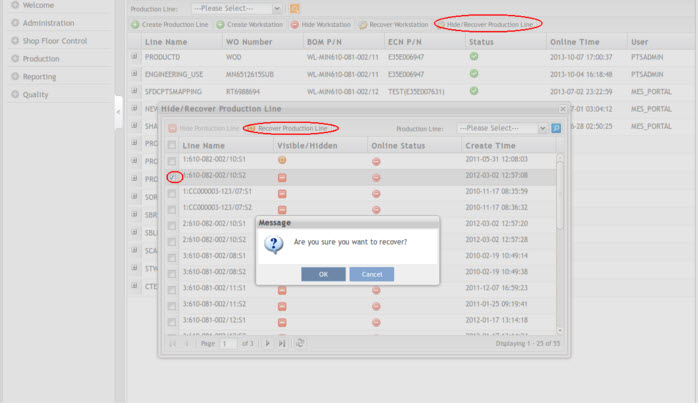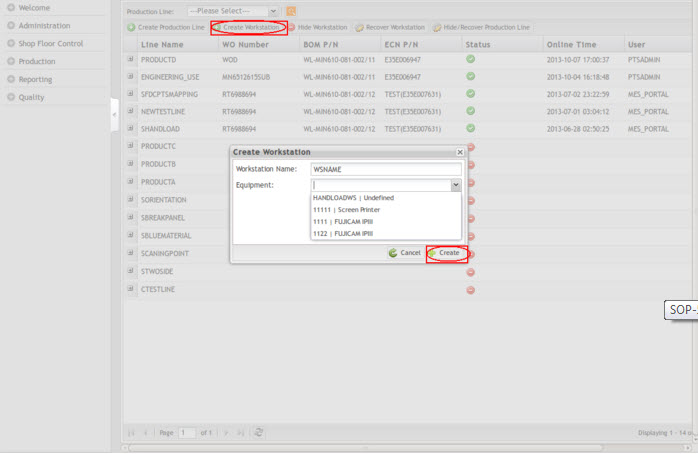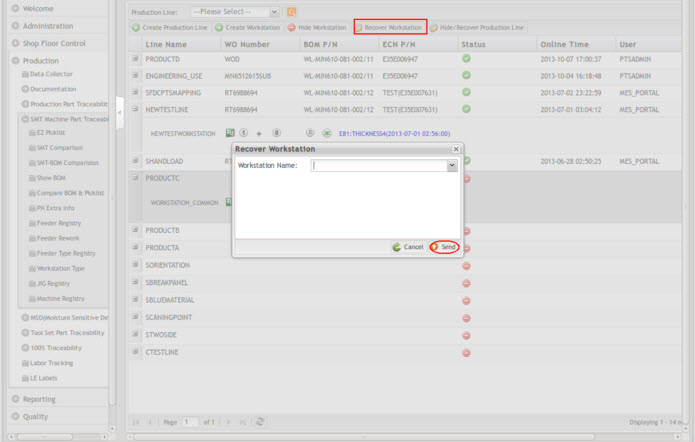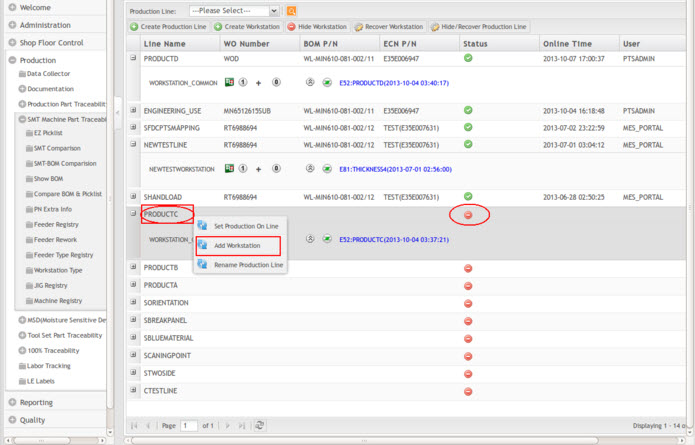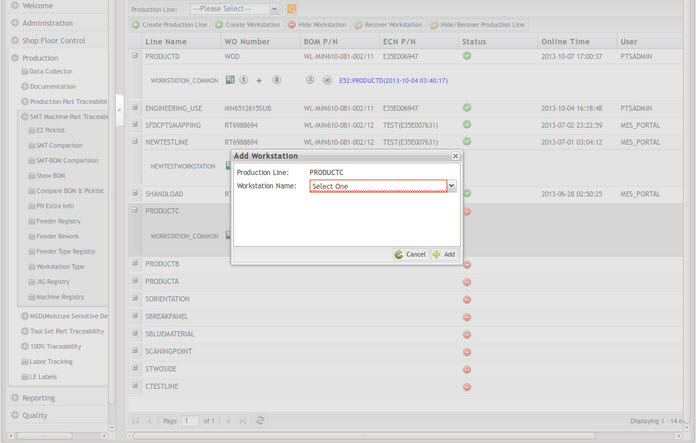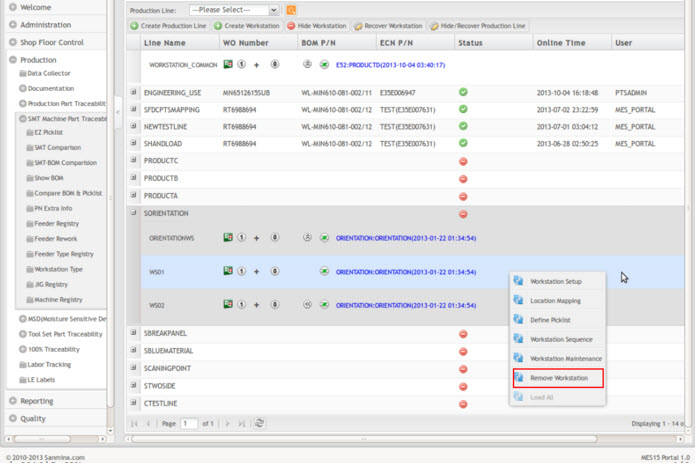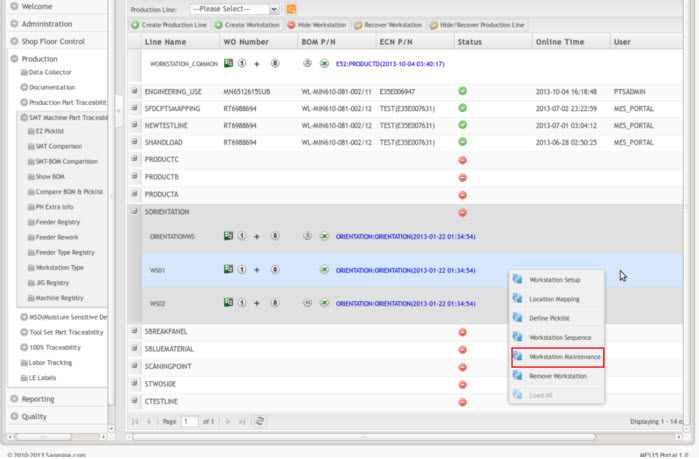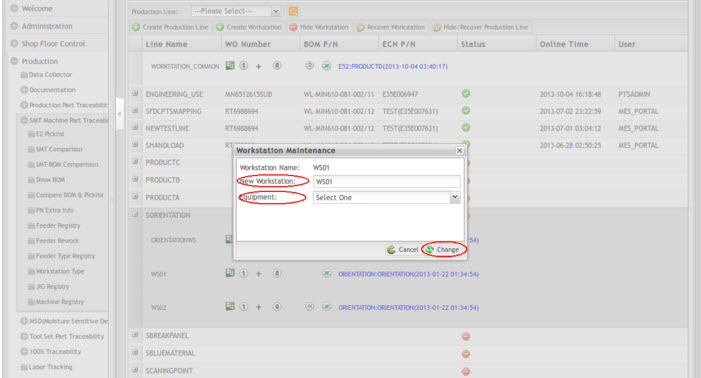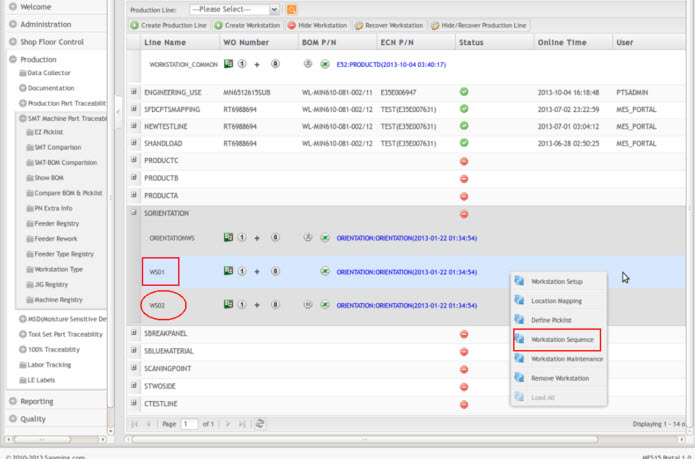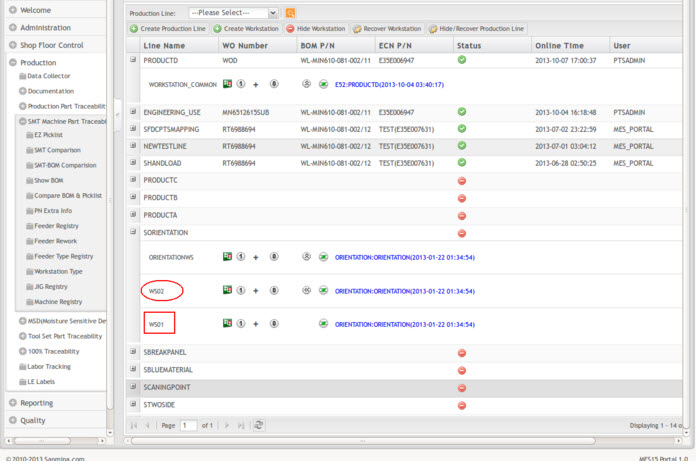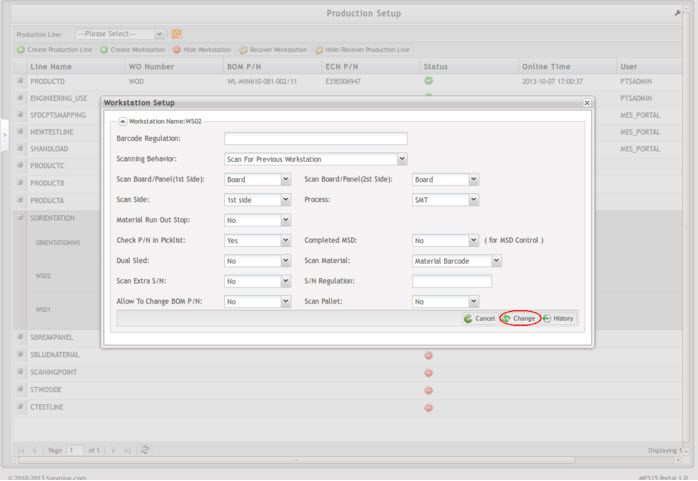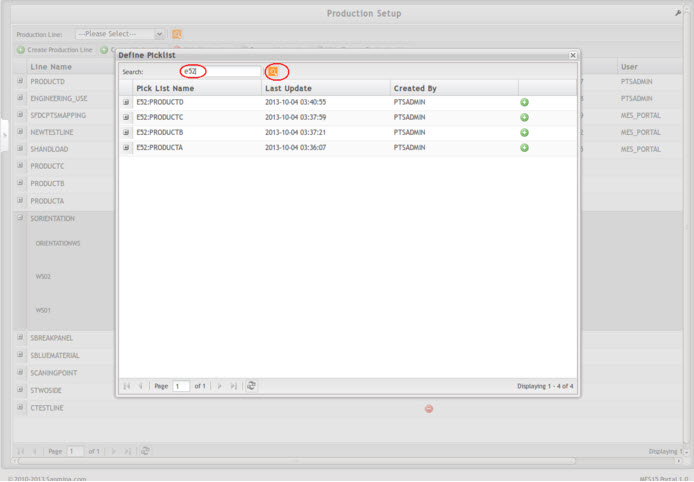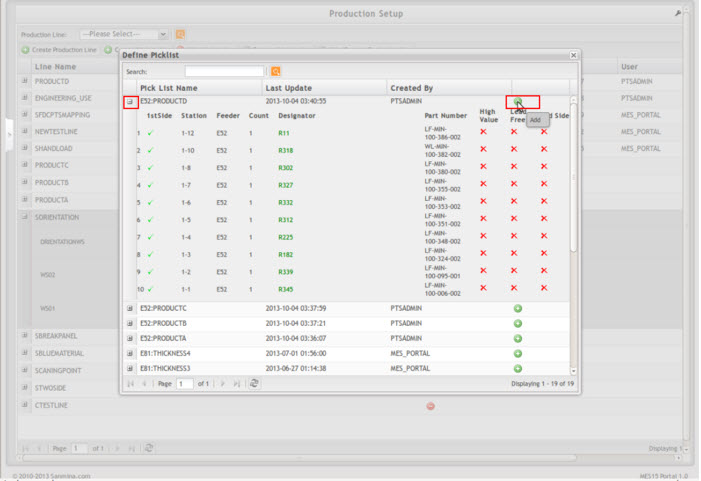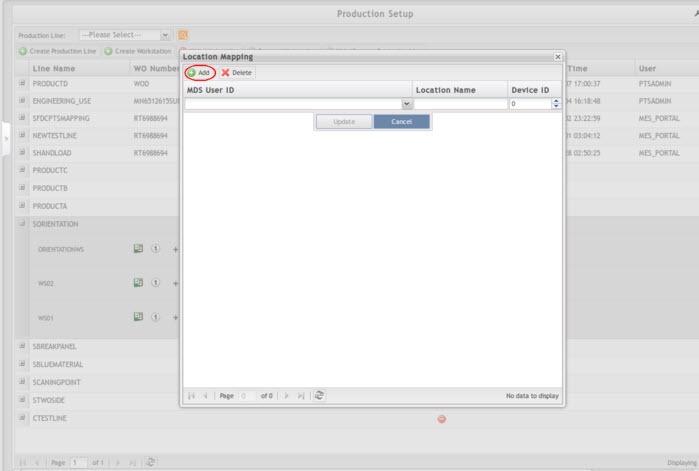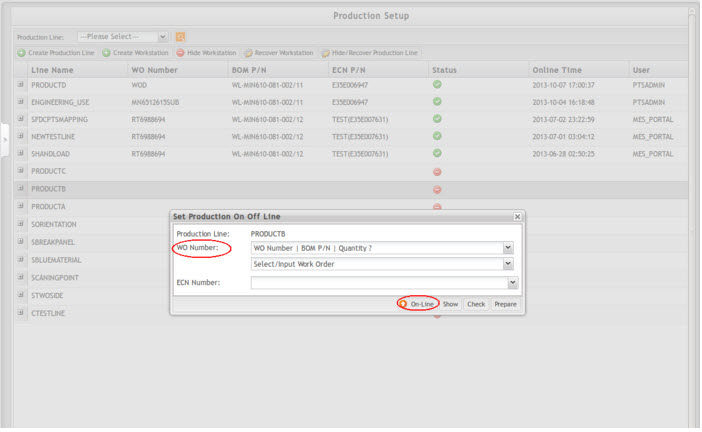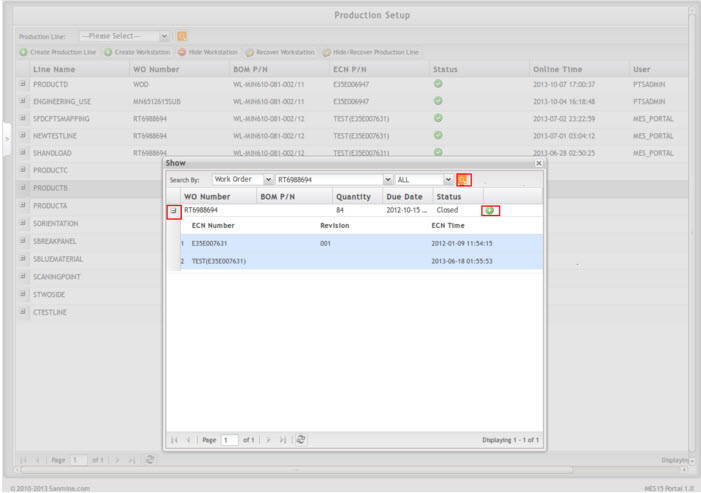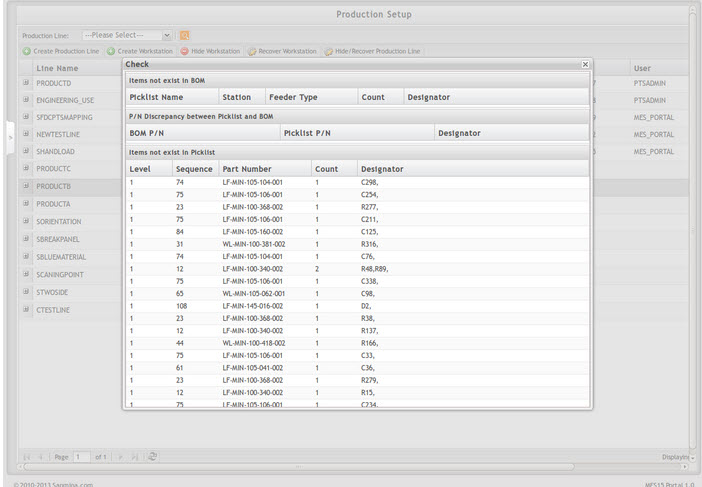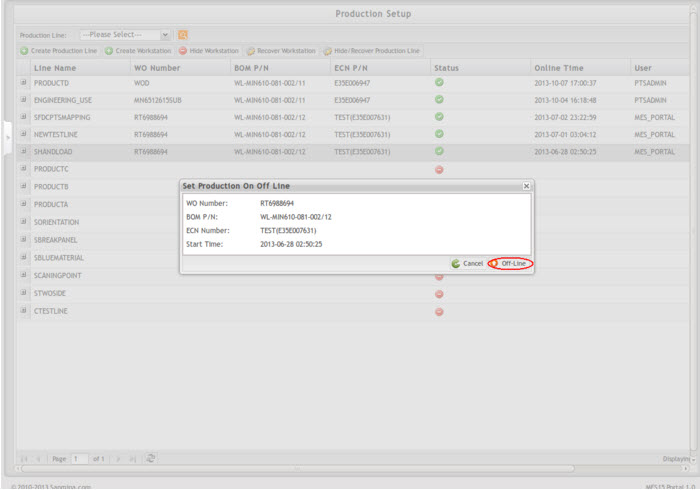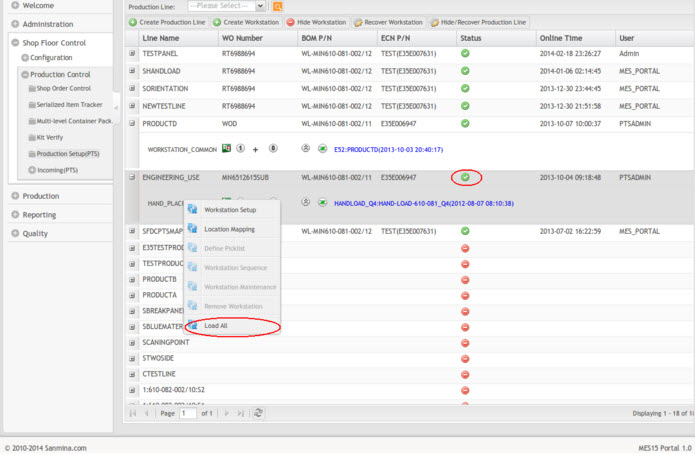Difference between revisions of "SOP-42Q-MES0024 Traceability Setup"
Helena wang (talk | contribs) |
|||
| Line 9: | Line 9: | ||
<center> </center> <center>'''Traceability Setup'''</center> <center>'''Version MES15 Portal 1.0'''</center> <center>'''Work Instruction'''</center> | <center> </center> <center>'''Traceability Setup'''</center> <center>'''Version MES15 Portal 1.0'''</center> <center>'''Work Instruction'''</center> | ||
| | ||
| − | <center>This | + | <center>This SOP is 42Q's corporate standard.</center> <center> This document is under revision control. The latest revision is located on Intranet.</center> <center> Once printed it is an uncontrolled copy. All alterations to this work instruction require approval.</center> <center> Contact the IT Global Education and Training Department to submit suggested alterations and or updates.</center> |
| − | ''This edition applies to MES15 Portal 1.0 Application and all subsequent releases and modifications until otherwise indicated in new revisions.'' | + | ''This edition applies to the MES15 Portal 1.0 Application and all subsequent releases and modifications until otherwise indicated in new revisions.'' |
| − | == SFDC Production Control == | + | == <span class="mw-headline" id="SFDC_Production_Control">SFDC Production Control</span> == |
As its name implies, the Shop Floor Data Collection (SFDC) system is responsible for the collection of data from the shop floor. The collected information is then stored in the Manufacturing Execution System (MES). Specifically, the real-time information collected by SFDC is utilized by Reporting and MES Web to create quality control reports. The SFDC system uses manual and automated barcode scanning to monitor and collect data for a product line or plant. Thus SFDC plays an important role in maintaining unit histories and directing product movement on the manufacturing floor. | As its name implies, the Shop Floor Data Collection (SFDC) system is responsible for the collection of data from the shop floor. The collected information is then stored in the Manufacturing Execution System (MES). Specifically, the real-time information collected by SFDC is utilized by Reporting and MES Web to create quality control reports. The SFDC system uses manual and automated barcode scanning to monitor and collect data for a product line or plant. Thus SFDC plays an important role in maintaining unit histories and directing product movement on the manufacturing floor. | ||
| − | The system provides Access Control between the modules of the application, including the functionalities of each screen. The current version has an SFDC Configuration page which provides access to all sub modules pages and | + | The system provides Access Control between the modules of the application, including the functionalities of each screen. The current version has an SFDC Configuration page which provides access to all sub modules pages and their functionalities (view, add, edit, delete, print, and generate output file). |
'''General Notes''' | '''General Notes''' | ||
| − | *This Work Instruction is a basic general training guide and is not meant to teach the process flow for individual plant or department functionality. Individual 42Q sites may have minor or specific process changes that will be documented at the site level. | + | *This Work Instruction is a basic general training guide and is not meant to teach the process flow for an individual plant or department functionality. Individual 42Q sites may have minor or specific process changes that will be documented at the site level. |
'''Assumptions''' | '''Assumptions''' | ||
| Line 26: | Line 26: | ||
*Availability of SMT material placement program (e.g. Fuji SMT job program) or Hand load material placement (e.g. Material items and associated reference designator under Hand load operation). | *Availability of SMT material placement program (e.g. Fuji SMT job program) or Hand load material placement (e.g. Material items and associated reference designator under Hand load operation). | ||
*Serial number printed on board prior SMT and/or Hand load operation process. | *Serial number printed on board prior SMT and/or Hand load operation process. | ||
| − | *Each SMT machine has been assigned a unique name for identification | + | *Each SMT machine has been assigned a unique name for identification purposes. (i.e. Workstation name) |
'''Prerequisites''' | '''Prerequisites''' | ||
| Line 62: | Line 62: | ||
| ''Refer 2.8 Workstation Setup.'' | | ''Refer 2.8 Workstation Setup.'' | ||
|- | |- | ||
| − | | 7.<br/> Define Picklist for each above added Workstation(s). | + | | 7.<br/> Define Picklist for each above-added Workstation(s). |
| ''Refer 2.9 Define Picklist.'' | | ''Refer 2.9 Define Picklist.'' | ||
|- | |- | ||
| Line 74: | Line 74: | ||
'''Scenario 2''' | '''Scenario 2''' | ||
| − | Production Setup for a previous built production item on | + | Production Setup for a previous built production item on was previously built shop floor production line, suggested following the steps below in PTS: |
{| border="2" cellpadding="4" cellspacing="0" width="100%" | {| border="2" cellpadding="4" cellspacing="0" width="100%" | ||
|- | |- | ||
| − | | 1. | + | | 1.Convert and upload SMT Picklist into PTS. |
| ''Refer SOP-5-I-PTS0014, Define EZ Pick List.'' | | ''Refer SOP-5-I-PTS0014, Define EZ Pick List.'' | ||
|- | |- | ||
| − | | 2. | + | | 2.Define Picklist for each Workstation that corresponding to the associated Production Line. |
| ''Refer 2.9 Define Picklist.'' | | ''Refer 2.9 Define Picklist.'' | ||
|- | |- | ||
| − | | 3. | + | | 3.Set Production Online. |
| ''Refer 2.11 Set Production On/Off-Line.'' | | ''Refer 2.11 Set Production On/Off-Line.'' | ||
|} | |} | ||
| − | ''' | + | <u>'''Note:'''</u> This work instruction is a general training guide and is not intended to provide a shop floor production process flow for all individual plants or departments. |
| − | + | <u>'''Note:'''</u> Please avoid setting up a new assembly on any existing created production line in PTS. It is recommended to have a PTS production line naming setup for one specific assembly exclusively. | |
| − | + | == <span class="mw-headline" id="Traceability_Setup">Traceability Setup</span> == | |
| − | + | 1. To access the traceability Setup page, navigate to '''Shop Floor Control > Production Control > Traceability Setup.''' | |
| − | |||
| − | |||
| − | |||
| − | 1. To access the traceability Setup page, navigate to '''Shop Floor Control | ||
'''Figure 1: Traceability Setup ''' | '''Figure 1: Traceability Setup ''' | ||
| − | [[File:Figure 1- Traceability Setup.png|border|800px]] | + | [[File:Figure 1- Traceability Setup.png|border|800px|Figure 1- Traceability Setup.png]] |
| | ||
| Line 108: | Line 104: | ||
| | ||
| − | === Create a New Production Line === | + | === <span class="mw-headline" id="Create_a_New_Production_Line">Create a New Production Line</span> === |
'''Figure 2: Create New Line''' | '''Figure 2: Create New Line''' | ||
| Line 118: | Line 114: | ||
1. Select '''Create Production Line'''. | 1. Select '''Create Production Line'''. | ||
| − | 2. Enter the new Production Line Name. (See following section for naming format suggestions). | + | 2. Enter the new Production Line Name. (See the following section for naming format suggestions). |
| − | 3. Select '''Create''' to confirm addition. | + | 3. Select '''Create''' to confirm the addition. |
Note the following naming conventions for the Production Line. | Note the following naming conventions for the Production Line. | ||
| Line 126: | Line 122: | ||
'''By Shop Floor Location''' | '''By Shop Floor Location''' | ||
| − | Format: Area Location | + | Format: Area Location <nowiki>+</nowiki> Production Zone - Production Part Number - Production Process - Production Side |
| − | <nowiki>+</nowiki> | ||
| − | |||
| − | Production Zone - Production Part Number - Production Process - Production Side | ||
Area Location: F (Floor), G (Ground) | Area Location: F (Floor), G (Ground) | ||
| Line 143: | Line 136: | ||
Example: F2-ABC12345-S-T | Example: F2-ABC12345-S-T | ||
| − | Production Line for | + | Production Line for product ABC12345 top side SMT production at 2<sup>nd</sup>floor'''.''' |
'''By Production Process''' | '''By Production Process''' | ||
| Line 162: | Line 155: | ||
Example: S2-ABC12345-T | Example: S2-ABC12345-T | ||
| − | Production Line for | + | Production Line for product ABC12345 top side at SMT Line/Zone 2. |
| − | === Search a Production Line === | + | === <span class="mw-headline" id="Search_a_Production_Line">Search a Production Line</span> === |
'''Figure 3: Search Production Line''' | '''Figure 3: Search Production Line''' | ||
| Line 172: | Line 165: | ||
| | ||
| − | 1. Enter the production line name or | + | 1. Enter the production line name or keywords in the Search Line Name field. |
2. Select the line name from the list. | 2. Select the line name from the list. | ||
| Line 178: | Line 171: | ||
3. The related production line will be listed in Production Line Available text box. | 3. The related production line will be listed in Production Line Available text box. | ||
| − | + | '''<u>Note:</u>''' Input the first 1 or 4 keywords for the line name, then the line name will display. | |
| | ||
| − | === Rename Production Line === | + | === <span class="mw-headline" id="Rename_Production_Line">Rename Production Line</span> === |
'''Figure 4: Rename Production Line''' | '''Figure 4: Rename Production Line''' | ||
| Line 206: | Line 199: | ||
| | ||
| − | + | '''<u>Note:</u>''' The production line name can be changed only when the production line is in offline mode. | |
| | ||
| − | + | === <span class="mw-headline" id="Hide.2FRecover_Production_Line">Hide/Recover Production Line</span> === | |
| − | |||
| − | === Hide/Recover Production Line === | ||
| − | |||
| − | |||
| − | If you | + | If you need to hide the obsolete PTS Production Lines, then you can do that by yourself as following steps. Otherwise, the MES Support team will be able to help you out if you need to do something at the database level. |
'''Figure 6: Hide/Recover Production Line''' | '''Figure 6: Hide/Recover Production Line''' | ||
| Line 250: | Line 239: | ||
5. Select '''OK''' to recover the production line or '''Cancel''' to exit. | 5. Select '''OK''' to recover the production line or '''Cancel''' to exit. | ||
| − | + | <u>'''Note:'''</u> The online production line not allowed to be hidden. Please set the production line to "off-line" before hiding it. | |
| − | === Workstation === | + | === <span class="mw-headline" id="Workstation">Workstation</span> === |
| − | ==== Create a New Workstation ==== | + | ==== <span class="mw-headline" id="Create_a_New_Workstation">Create a New Workstation</span> ==== |
| − | 1. Select '''Create Workstation''' from the functional | + | 1. Select '''Create Workstation''' from the functional options menu. (See the following section for naming format suggestions). |
2. '''Workstation Name''': Enter the workstation name. | 2. '''Workstation Name''': Enter the workstation name. | ||
| Line 272: | Line 261: | ||
| | ||
| − | + | <u>'''Note:'''</u> The equipment should be added first in '''Production > ''''''SMT Machine part Traceability > Machine Registry''' module. | |
| − | + | The suggested naming format for Workstation | |
'''By Shop Floor Location''' | '''By Shop Floor Location''' | ||
| − | Format: Area Location | + | Format: Area Location <nowiki>+</nowiki> Production Zone - Placement Machine |
| − | <nowiki>+</nowiki> | ||
| − | |||
| − | Production Zone - Placement Machine | ||
Example: F2-CP6B | Example: F2-CP6B | ||
| − | Explanation: Fuji CP6B placement machine located | + | Explanation: Fuji CP6B placement machine located on 2<sup>nd</sup> Floor. |
'''By Production Process''' | '''By Production Process''' | ||
| − | Format: Production Process | + | Format: Production Process <nowiki>+</nowiki> Line/Zone - Placement Machine |
| − | <nowiki>+</nowiki> | ||
| − | |||
| − | Line/Zone - Placement Machine | ||
Example: S2-CP6A | Example: S2-CP6A | ||
| Line 304: | Line 287: | ||
Explanation: Fuji CP6 placement machine with its own unique machine serial number SN12345. | Explanation: Fuji CP6 placement machine with its own unique machine serial number SN12345. | ||
| − | ==== Hide WorkStation ==== | + | ==== <span class="mw-headline" id="Hide_WorkStation">Hide WorkStation</span> ==== |
'''Figure 10: Hide Workstation''' | '''Figure 10: Hide Workstation''' | ||
| Line 318: | Line 301: | ||
3. Select '''Send''' to hide the WorkStation or '''Cancel '''to exit. | 3. Select '''Send''' to hide the WorkStation or '''Cancel '''to exit. | ||
| − | ==== Recover WorkStation ==== | + | ==== <span class="mw-headline" id="Recover_WorkStation">Recover WorkStation</span> ==== |
'''Figure 11: Recover Work Station''' | '''Figure 11: Recover Work Station''' | ||
| Line 334: | Line 317: | ||
| | ||
| − | === Add WorkStation === | + | === <span class="mw-headline" id="Add_WorkStation">Add WorkStation</span> === |
| − | This module allows the user to add or remove workstation(s) from production line. | + | This module allows the user to add or remove workstation(s) from the production line. |
| − | ==== Adding Workstation into a Production Line ==== | + | ==== <span class="mw-headline" id="Adding_Workstation_into_a_Production_Line">Adding Workstation into a Production Line</span> ==== |
'''Figure 12: Add Workstation into a Production Line''' | '''Figure 12: Add Workstation into a Production Line''' | ||
| Line 348: | Line 331: | ||
1. Select the production line from the production Line list. | 1. Select the production line from the production Line list. | ||
| − | 2. Open the pop-up menu by right-clicking on the line name then select '''Add Workstation''' menu. Select the workstation name from Workstation name pull down list to add to the specific production line. | + | 2. Open the pop-up menu by right-clicking on the line name then select '''Add Workstation''' menu. Select the workstation name from the Workstation name pull-down list to add to the specific production line. |
3. Select '''Add''' to add the workstation. | 3. Select '''Add''' to add the workstation. | ||
| Line 360: | Line 343: | ||
| | ||
| − | + | <u>'''Note:'''</u> The selected production line must be off-line for workstation addition or removal. | |
| − | + | <u>'''Note:'''</u> The Workstation Name will auto-completed after entering the first 4 characters. | |
| − | ==== Removing Workstation from a Production Line ==== | + | ==== <span class="mw-headline" id="Removing_Workstation_from_a_Production_Line">Removing Workstation from a Production Line</span> ==== |
'''Figure 14: Remove Workstation''' | '''Figure 14: Remove Workstation''' | ||
[[File:SOP-5-I-MES0024-C Remove-Workstation.jpg|RTENOTITLE]] | [[File:SOP-5-I-MES0024-C Remove-Workstation.jpg|RTENOTITLE]] | ||
| − | |||
| − | |||
| | ||
| Line 376: | Line 357: | ||
1. Select the production line from the production Line list menu. | 1. Select the production line from the production Line list menu. | ||
| − | 2. Select the workstation name from Workstation pull down list which is under "In Use." | + | 2. Select the workstation name from the Workstation pull-down list which is under "In Use." |
| − | 3. Open the pop-up menu by right-clicking on the workstation then select '''Remove Workstation''' menu. | + | 3. Open the pop-up menu by right-clicking on the workstation then select the '''Remove Workstation''' menu. |
4. Select '''OK''' to remove the Workstation from this production line or select '''Cancel''' to exit. | 4. Select '''OK''' to remove the Workstation from this production line or select '''Cancel''' to exit. | ||
| Line 384: | Line 365: | ||
| | ||
| − | ==== WorkStation Maintenance ==== | + | ==== <span class="mw-headline" id="WorkStation_Maintenance">WorkStation Maintenance</span> ==== |
| | ||
| Line 391: | Line 372: | ||
[[File:SOP-5-I-MES0024-C Workstation-Maintenance.jpg|RTENOTITLE]] | [[File:SOP-5-I-MES0024-C Workstation-Maintenance.jpg|RTENOTITLE]] | ||
| − | |||
| − | |||
| | ||
| Line 400: | Line 379: | ||
2. Select the workstation from the workstation(s) list. | 2. Select the workstation from the workstation(s) list. | ||
| − | 3. Open the pop-up menu by right-clicking then select '''Workstation Maintenance''' option<font color="#00000A">.</font> | + | 3. Open the pop-up menu by right-clicking then select the '''Workstation Maintenance''' option<font color="#00000A">.</font> |
<font color="#00000A">4. </font>Renaming: Fill in a new workstation name in the '''New Workstation''' field and then select '''Change '''to rename the selected workstation name. | <font color="#00000A">4. </font>Renaming: Fill in a new workstation name in the '''New Workstation''' field and then select '''Change '''to rename the selected workstation name. | ||
| Line 414: | Line 393: | ||
| | ||
| − | <br/> | + | <br/> '''<u>Note:</u>''' The workstation can be renamed only when the production line is in "off-line" mode. |
(See Set Production Off-Line) | (See Set Production Off-Line) | ||
| Line 420: | Line 399: | ||
| | ||
| − | === Workstation Sequence === | + | === <span class="mw-headline" id="Workstation_Sequence">Workstation Sequence</span> === |
The purpose of this module is to redefine the proper workstation sequence for the production line if the previous setup is incorrect. | The purpose of this module is to redefine the proper workstation sequence for the production line if the previous setup is incorrect. | ||
| Line 448: | Line 427: | ||
| | ||
| − | + | <u>'''Note:'''</u> The workstation process sequence goes from down to up and is allowed under the '''Workstation Sequence''' option. Please move each workstation to the correct workstation process sequence if required. | |
| | ||
| − | + | === <span class="mw-headline" id="Workstation_Setup">Workstation Setup</span> === | |
| − | + | This module allows the user to set up the scanning behavior and scanning rules for each defined Workstation under the associated Production Line. | |
| − | |||
| − | |||
| − | |||
| − | This module allows the user to | ||
| | ||
| Line 473: | Line 448: | ||
3. Select '''Workstation Setup'''. | 3. Select '''Workstation Setup'''. | ||
| + | |||
| + | | ||
'''Workstation Setup Parameters''' | '''Workstation Setup Parameters''' | ||
| Line 483: | Line 460: | ||
*'''Scan by Later Workstation: '''All workstation material placements can be recorded with the next Workstation(s). | *'''Scan by Later Workstation: '''All workstation material placements can be recorded with the next Workstation(s). | ||
| − | *'''Must Scan At this Workstation: '''All workstation material placements are required to be recorded at this Workstation before reach and/or scan at next Workstation(s). | + | *'''Must Scan At this Workstation: '''All workstation material placements are required to be recorded at this Workstation before reach and/or scan at the next Workstation(s). |
| − | *'''Scan for Previous Workstation: '''All | + | *'''Scan for Previous Workstation: '''All these workstation material placements will be recorded with the previous Workstation placements. |
3. '''Scan Board/Panel:''' '''(Compulsory)''' | 3. '''Scan Board/Panel:''' '''(Compulsory)''' | ||
| Line 496: | Line 473: | ||
4. '''Scan Extra S/N: (Compulsory)''' | 4. '''Scan Extra S/N: (Compulsory)''' | ||
| − | Define if extra serial need to be scanned. If it is required to scan the PCB | + | Define if extra serial need to be scanned. If it is required to scan the PCB board's additional barcodes such as the package label, select '''Yes'''. Default is '''No'''. |
5. '''S/N Regulation:''' '''(Required if Scan Extra S/N is Yes)''' | 5. '''S/N Regulation:''' '''(Required if Scan Extra S/N is Yes)''' | ||
| Line 514: | Line 491: | ||
*'''1st Side''': First PCB production side or One PCB production side. | *'''1st Side''': First PCB production side or One PCB production side. | ||
| − | I.e. Such as PCB | + | I.e. Such as PCB<nowiki>’</nowiki>s TOP side production only which does only have material placements on one PCB side. |
| − | <nowiki>’</nowiki> | ||
| − | |||
| − | s TOP side production only which | ||
*'''2nd Side''': Second PCB production side. | *'''2nd Side''': Second PCB production side. | ||
| − | I.e. Such as TOP side can be called 2<sup>nd</sup> Side as it is the second production side after BOTTOM side placement finished. | + | I.e. Such as the TOP side can be called the 2<sup>nd</sup> Side as it is the second production side after the BOTTOM side placement finished. |
*'''1<sup>st</sup>& 2<sup>nd</sup> Side: '''Top and Bottom side. | *'''1<sup>st</sup>& 2<sup>nd</sup> Side: '''Top and Bottom side. | ||
| Line 532: | Line 506: | ||
*Select '''Material Barcode''' (For plant which used PTS format material label that included a unique printed PTS material barcode). | *Select '''Material Barcode''' (For plant which used PTS format material label that included a unique printed PTS material barcode). | ||
| − | *Select '''SSCI P/N''' (For plant which might used standard plant approved / developed material label that included printed SSCI Part Number barcode). | + | *Select '''SSCI P/N''' (For plant which might be used standard plant approved/developed material label that included printed SSCI Part Number barcode). |
| − | *Select '''Manufacturer P/N''' (For plant | + | *Select '''Manufacturer P/N''' (For a plant that might use the manufacturer-provided label that included printed manufacturer Part Number barcode) |
9. '''Process: (Compulsory)''' | 9. '''Process: (Compulsory)''' | ||
| Line 545: | Line 519: | ||
c. '''AI''': For Auto Insertion workstation. | c. '''AI''': For Auto Insertion workstation. | ||
| − | + | '''<u>Note:</u>''' Different setup option defines different material loading process. Refer to the Load Material work instruction for more detail. | |
10. '''Device ID''': (Optional) | 10. '''Device ID''': (Optional) | ||
| Line 555: | Line 529: | ||
12. Select '''History''' to check the log for the change of setup parameters. | 12. Select '''History''' to check the log for the change of setup parameters. | ||
| − | === Define Pick List === | + | === <span class="mw-headline" id="Define_Pick_List">Define Pick List</span> === |
This module allows the user to assign the early prepared/loaded SMT placement program into a Workstation under the specific Production Line. | This module allows the user to assign the early prepared/loaded SMT placement program into a Workstation under the specific Production Line. | ||
| Line 571: | Line 545: | ||
3. Select '''Define Picklist'''. | 3. Select '''Define Picklist'''. | ||
| − | 4. Enter the keywords for Picklist name. | + | 4. Enter the keywords for the Picklist name. |
5. Select '''Search''' to search Picklist name. | 5. Select '''Search''' to search Picklist name. | ||
| Line 585: | Line 559: | ||
| | ||
| − | 7. Select " | + | 7. Select "<nowiki>+</nowiki>" to assign the selected picklist to the Workstation. |
| − | <nowiki>+</nowiki> | ||
| − | + | <u>'''Note:'''</u> For additional Picklist information, see the SMT Part Traceability work instruction. | |
| − | + | === <span class="mw-headline" id="Location_mapping">Location mapping</span> === | |
| − | + | This sub-module is designed to map the PTS workstation with the SFDC location so that SFDC will forward serial number information to the pre-mapped PTS workstation upon board scanning, which helps to avoid duplicate board scanning and improve production efficiency. | |
| − | + | To map a PTS workstation with an SFDC location, please select the workstation of a production line, and right-click to open the pop-up menu then click on '''Location Mapping.''' | |
| − | |||
| − | To map a PTS workstation with | ||
<br/> '''Figure 22: Location Mapping Interface''' | <br/> '''Figure 22: Location Mapping Interface''' | ||
| Line 604: | Line 575: | ||
<br/> 1. To update an existing mapping, double click on existing mapping; edit the information, then select '''Update'''. | <br/> 1. To update an existing mapping, double click on existing mapping; edit the information, then select '''Update'''. | ||
| − | 2. To delete existing mapping, select '''Delete'''. | + | 2. To delete the existing mapping, select '''Delete'''. |
| − | 3. To configure a new mapping, select '''Add''' and a new line will be created. | + | 3. To configure a new mapping, select '''Add,''' and a new line will be created. |
*MES User ID (Mandatory): SFDC user ID at MES. Select from the drop-down list. | *MES User ID (Mandatory): SFDC user ID at MES. Select from the drop-down list. | ||
| − | *Location Name (Mandatory): Fill in SFDC location name that to be mapped with selected PTS workstation. | + | *Location Name (Mandatory): Fill in the SFDC location name that to be mapped with the selected PTS workstation. |
*Device ID (Optional): Fill in SFDC Device ID. | *Device ID (Optional): Fill in SFDC Device ID. | ||
*Select '''Update''' to complete the mapping or '''Cancel''' to exit. | *Select '''Update''' to complete the mapping or '''Cancel''' to exit. | ||
| Line 615: | Line 586: | ||
| | ||
| − | === Set Production On/Off-Line === | + | === <span class="mw-headline" id="Set_Production_On.2FOff-Line">Set Production On/Off-Line</span> === |
| − | ==== Set Production On-Line ==== | + | ==== <span class="mw-headline" id="Set_Production_On-Line">Set Production On-Line</span> ==== |
*Once the user has the production line and workstation ready, the production line must be set to" On-Line" mode to start work order production. The user cannot load material or scan board if the production line is off. | *Once the user has the production line and workstation ready, the production line must be set to" On-Line" mode to start work order production. The user cannot load material or scan board if the production line is off. | ||
| Line 629: | Line 600: | ||
| | ||
| − | 1. Select the production line to be set | + | 1. Select the production line to be set online from the production Line list. |
2. Open the pop-up menu by right-clicking, and then select '''Set Production online'''. | 2. Open the pop-up menu by right-clicking, and then select '''Set Production online'''. | ||
| Line 635: | Line 606: | ||
3. Enter a released Work Order number, if known, or Select the work order from the list by selecting '''Show'''. | 3. Enter a released Work Order number, if known, or Select the work order from the list by selecting '''Show'''. | ||
| − | 4. Select the Work Order (you can view the BOM detail by selecting the " | + | 4. Select the Work Order (you can view the BOM detail by selecting the " <nowiki>+</nowiki> " at the left). |
| − | <nowiki>+</nowiki> | ||
| − | |||
| − | " at the left). | ||
| − | |||
| − | |||
| − | |||
| − | " at the right to select the Work order. | + | 5. Select the " <nowiki>+</nowiki> " at the right to select the Work order. |
6. Select '''Check''' in the '''BOM/PL''' column to verify the BOM against the defined picklist and vice versa, below two sessions, if there are unmatched items. | 6. Select '''Check''' in the '''BOM/PL''' column to verify the BOM against the defined picklist and vice versa, below two sessions, if there are unmatched items. | ||
| Line 663: | Line 628: | ||
*'''Items that do not exist in BOM''' | *'''Items that do not exist in BOM''' | ||
| − | To compare and validate all material placements in SMT placement program (i.e. PickList) that | + | To compare and validate all material placements in the SMT placement program (i.e. PickList) that do not exist in ERP BOM. |
*'''Items that do not exist in PickList''' | *'''Items that do not exist in PickList''' | ||
| Line 669: | Line 634: | ||
To compare and validate all material placements in ERP BOM that does not exist in SMT placement program (i.e. PickList). | To compare and validate all material placements in ERP BOM that does not exist in SMT placement program (i.e. PickList). | ||
| − | 7. Fill the required Work Order with associated production ECN. | + | 7. Fill in the required Work Order with associated production ECN. |
8. Select '''On-line''' to set the production line online after confirming the Work Order and ECN selection. | 8. Select '''On-line''' to set the production line online after confirming the Work Order and ECN selection. | ||
| − | + | <u>'''Note:'''</u> If the work order BOM components do not match the defined picklist, the user will need to follow confirmation and update accordingly. | |
| − | |||
| − | If the work order BOM components do not match the defined picklist , the user will need to follow confirmation and update accordingly. | ||
*Confirm that the Work Order you enter/select is associated with the latest ECN. | *Confirm that the Work Order you enter/select is associated with the latest ECN. | ||
| Line 682: | Line 645: | ||
| | ||
| − | ==== Set Production Off-Line ==== | + | ==== <span class="mw-headline" id="Set_Production_Off-Line">Set Production Off-Line</span> ==== |
Once the work order is completed on the production line, the production line needs to be set to Off-Line mode. | Once the work order is completed on the production line, the production line needs to be set to Off-Line mode. | ||
| − | 1. Select the production line to be set | + | 1. Select the production line to be set online from the production Line list. |
2. Open the pop-up menu by right-clicking then select '''Set Production offline'''. | 2. Open the pop-up menu by right-clicking then select '''Set Production offline'''. | ||
| − | 3. Choose '''Set Production On/Off Line''' functional module. | + | 3. Choose '''Set Production On/Off-Line''' functional module. |
| − | 4. Select '''Off Line''' to set the line offline. | + | 4. Select '''Off-Line''' to set the line offline. |
| | ||
| Line 702: | Line 665: | ||
| | ||
| − | === Load All === | + | === <span class="mw-headline" id="Load_All">Load All</span> === |
This module allows the user to load all materials to the workstation under the following conditions. | This module allows the user to load all materials to the workstation under the following conditions. | ||
| Line 708: | Line 671: | ||
1. Set the production line offline (do not unload materials). | 1. Set the production line offline (do not unload materials). | ||
| − | 2. Change setting for the workstation if needed. | + | 2. Change the setting for the workstation if needed. |
3. Set the production line to online again. | 3. Set the production line to online again. | ||
| Line 714: | Line 677: | ||
4. The user can use the "Load All" function to load all materials to the workstation. | 4. The user can use the "Load All" function to load all materials to the workstation. | ||
| − | + | <u>'''Note:'''</u> The user can only load all when not using the unload function. | |
| − | + | <u>'''Note:'''</u> If some materials are invalid/expired, those materials will fail to load if using the "load all" function. All other valid materials will load successfully. | |
| | ||
| Line 726: | Line 689: | ||
| | ||
| − | 1. Set the production line | + | 1. Set the production line to online from the Production Line list. |
| − | |||
| − | |||
| − | |||
| − | " at the left. | + | 2. Open the workstation lists by selecting the " <nowiki>+</nowiki> " at the left. |
3. Open the pop-up menu by right-clicking on the workstation, and then select '''Load All'''. | 3. Open the pop-up menu by right-clicking on the workstation, and then select '''Load All'''. | ||
| Line 737: | Line 697: | ||
4. The information will display if the Load All function succeeds. | 4. The information will display if the Load All function succeeds. | ||
| − | 5. The user can check the loaded material | + | 5. The user can check the loaded material on the page "Load Material Report." |
| − | == Further Information == | + | == <span class="mw-headline" id="Further_Information">Further Information</span> == |
This completes PTS Production Setup information. For further information on a specific functional area refer to Intranet. | This completes PTS Production Setup information. For further information on a specific functional area refer to Intranet. | ||
| Line 753: | Line 713: | ||
---- | ---- | ||
| − | == Document Revision History == | + | == <span class="mw-headline" id="Document_Revision_History">Document Revision History</span> == |
{| border="2" cellpadding="4" cellspacing="0" width="100%" | {| border="2" cellpadding="4" cellspacing="0" width="100%" | ||
| Line 781: | Line 741: | ||
| Format for WIKI | | Format for WIKI | ||
|- | |- | ||
| − | | 04/03/ | + | | 04/03/16 |
| Elaine Fonaro | | Elaine Fonaro | ||
| Technical Writer | | Technical Writer | ||
Revision as of 17:54, 20 May 2021
42Q Home > Shop Floor Control > Production Control > Traceability Setup

This edition applies to the MES15 Portal 1.0 Application and all subsequent releases and modifications until otherwise indicated in new revisions.
Contents
- 1 SFDC Production Control
- 2 Traceability Setup
- 3 Further Information
- 4 Document Revision History
SFDC Production Control
As its name implies, the Shop Floor Data Collection (SFDC) system is responsible for the collection of data from the shop floor. The collected information is then stored in the Manufacturing Execution System (MES). Specifically, the real-time information collected by SFDC is utilized by Reporting and MES Web to create quality control reports. The SFDC system uses manual and automated barcode scanning to monitor and collect data for a product line or plant. Thus SFDC plays an important role in maintaining unit histories and directing product movement on the manufacturing floor.
The system provides Access Control between the modules of the application, including the functionalities of each screen. The current version has an SFDC Configuration page which provides access to all sub modules pages and their functionalities (view, add, edit, delete, print, and generate output file).
General Notes
- This Work Instruction is a basic general training guide and is not meant to teach the process flow for an individual plant or department functionality. Individual 42Q sites may have minor or specific process changes that will be documented at the site level.
Assumptions
- Availability of SMT material placement program (e.g. Fuji SMT job program) or Hand load material placement (e.g. Material items and associated reference designator under Hand load operation).
- Serial number printed on board prior SMT and/or Hand load operation process.
- Each SMT machine has been assigned a unique name for identification purposes. (i.e. Workstation name)
Prerequisites
1. Understand PTS terms definition from Glossary SOP-5-I-MES0044-C_RA_PTS GLOSSARY
2. Pick List has been obtained from plant engineering and uploaded into PTS, for EZ-Pick List – Refer to SOP-5-I-MES0049
Overview
This overview explains the process for production setup in PTSWEB base on the following two different production setup scenarios:
Scenario 1
Production Setup for a new (or previous built) product item on a new shop floor production line, suggested following the steps below in PTS:
| 1. Convert and upload SMT Picklist into PTS. |
Refer SOP-5-I-MES0049, Define EZ Pick List. |
| 2. Create a New Production Line. |
Refer to 2.1 Create a New Production Line. |
| 3. Create all required Workstation(S). |
Refer to 2.5.1 Create a New Workstation. |
| 4. Add the Workstations into the Production Line by sequence. |
Refer 2.6.1 Add a Workstation into a Production Line. |
| 5. Define Workstation Process Sequence in a Production Line. |
Refer to 2.7 Workstation Sequence. |
| 6. Define Workstation Parameters for each added Workstation(s). |
Refer 2.8 Workstation Setup. |
| 7. Define Picklist for each above-added Workstation(s). |
Refer 2.9 Define Picklist. |
| 8. Define Auto-Scan Mapping. (Optional) |
Refer 2.10 Location Mapping. |
| 9. Set Production Online. |
Refer 2.11 Set Production On/Off-Line. |
Scenario 2
Production Setup for a previous built production item on was previously built shop floor production line, suggested following the steps below in PTS:
| 1.Convert and upload SMT Picklist into PTS. | Refer SOP-5-I-PTS0014, Define EZ Pick List. |
| 2.Define Picklist for each Workstation that corresponding to the associated Production Line. | Refer 2.9 Define Picklist. |
| 3.Set Production Online. | Refer 2.11 Set Production On/Off-Line. |
Note: This work instruction is a general training guide and is not intended to provide a shop floor production process flow for all individual plants or departments.
Note: Please avoid setting up a new assembly on any existing created production line in PTS. It is recommended to have a PTS production line naming setup for one specific assembly exclusively.
Traceability Setup
1. To access the traceability Setup page, navigate to Shop Floor Control > Production Control > Traceability Setup.
Figure 1: Traceability Setup
Figure 1- Traceability Setup.png
Create a New Production Line
Figure 2: Create New Line
1. Select Create Production Line.
2. Enter the new Production Line Name. (See the following section for naming format suggestions).
3. Select Create to confirm the addition.
Note the following naming conventions for the Production Line.
By Shop Floor Location
Format: Area Location + Production Zone - Production Part Number - Production Process - Production Side
Area Location: F (Floor), G (Ground)
Production Zone: Floor level or zone area in production either in alpha or number format.
Production Part Number: as named.
Production Process: S (SMT), H (Hand Load)
Production Side: T (Top), B (Bottom)
Example: F2-ABC12345-S-T
Production Line for product ABC12345 top side SMT production at 2ndfloor.
By Production Process
Format: Production Process +
Production Zone – Production Part Number – Production Side
Production Process: S (SMT), H (Hand Load)
Production Zone: Floor level or zone area in production either in alpha or number format.
Production Part Number: as named.
Production Side: T (Top), B (Bottom)
Example: S2-ABC12345-T
Production Line for product ABC12345 top side at SMT Line/Zone 2.
Search a Production Line
Figure 3: Search Production Line
1. Enter the production line name or keywords in the Search Line Name field.
2. Select the line name from the list.
3. The related production line will be listed in Production Line Available text box.
Note: Input the first 1 or 4 keywords for the line name, then the line name will display.
Rename Production Line
Figure 4: Rename Production Line
1. Select the production line from the Production Line list.
2. Open the pop-up menu by Right-Clicking, and then select Rename Production Line.
3. Enter the New Name in "New Production Line".
4. Select Change to rename the production line.
Figure 5: Rename Production Line Form
Note: The production line name can be changed only when the production line is in offline mode.
Hide/Recover Production Line
If you need to hide the obsolete PTS Production Lines, then you can do that by yourself as following steps. Otherwise, the MES Support team will be able to help you out if you need to do something at the database level.
Figure 6: Hide/Recover Production Line
1. Select Hide/Recover Production line.
Figure 7: Hide a Production Line
2. Select a production line (The line is in offline and visible status) then select Hide Production Line.
3. Select OK to hide the production line or Cancel to exit.
Figure 8: Recover a Production Line
4. Select a production line (The line is in offline and hidden status) then select Recover Production Line.
5. Select OK to recover the production line or Cancel to exit.
Note: The online production line not allowed to be hidden. Please set the production line to "off-line" before hiding it.
Workstation
Create a New Workstation
1. Select Create Workstation from the functional options menu. (See the following section for naming format suggestions).
2. Workstation Name: Enter the workstation name.
3. Select the Equipment. (This is optional)
4. Select Create to create the new workstation.
Figure 9: Workstation Name and Equipment
'Note: The equipment should be added first in Production > 'SMT Machine part Traceability > Machine Registry module. The suggested naming format for Workstation By Shop Floor Location
Format: Area Location + Production Zone - Placement Machine
Example: F2-CP6B
Explanation: Fuji CP6B placement machine located on 2nd Floor.
By Production Process
Format: Production Process + Line/Zone - Placement Machine
Example: S2-CP6A
Explanation: Fuji CP6A placement machine located at SMT Line 2.
By Placement machine model with associated serial number
Format: Placement machine model – Placement machine serial number
Example: CP6-SN12345
Explanation: Fuji CP6 placement machine with its own unique machine serial number SN12345.
Hide WorkStation
Figure 10: Hide Workstation
1. Select Hide WorkStation.
2. Select a WorkStation (The Workstation should be at visible status)
3. Select Send to hide the WorkStation or Cancel to exit.
Recover WorkStation
Figure 11: Recover Work Station
1. Select Recover WorkStation.
2. Select a WorkStation (The Workstation is at hidden status).
3. Select Send to recover the WorkStation or Cancel to exit.
Add WorkStation
This module allows the user to add or remove workstation(s) from the production line.
Adding Workstation into a Production Line
Figure 12: Add Workstation into a Production Line
1. Select the production line from the production Line list.
2. Open the pop-up menu by right-clicking on the line name then select Add Workstation menu. Select the workstation name from the Workstation name pull-down list to add to the specific production line.
3. Select Add to add the workstation.
Figure 13: Add Workstation- Set Button
Note: The selected production line must be off-line for workstation addition or removal.
Note: The Workstation Name will auto-completed after entering the first 4 characters.
Removing Workstation from a Production Line
Figure 14: Remove Workstation
1. Select the production line from the production Line list menu.
2. Select the workstation name from the Workstation pull-down list which is under "In Use."
3. Open the pop-up menu by right-clicking on the workstation then select the Remove Workstation menu.
4. Select OK to remove the Workstation from this production line or select Cancel to exit.
WorkStation Maintenance
Figure 15: Workstation Maintenance
1. Select the production line from the production line list.
2. Select the workstation from the workstation(s) list.
3. Open the pop-up menu by right-clicking then select the Workstation Maintenance option.
4. Renaming: Fill in a new workstation name in the New Workstation field and then select Change to rename the selected workstation name.
5. Equipment: Select the Equipment, then select Change to reset the Workstation type.
Figure 16: Workstation Maintenance- Detail
Note: The workstation can be renamed only when the production line is in "off-line" mode.
(See Set Production Off-Line)
Workstation Sequence
The purpose of this module is to redefine the proper workstation sequence for the production line if the previous setup is incorrect.
Following is the example to redefine the workstation sequence:
Figure 17: Workstation Sequence in a Production Line- Before
1. Select the production line from the production Line list.
2. Select the workstation from the workstation(s) list.
3. Select Workstation Sequence to shift up the Workstation process sequence.
Figure 18: Workstation Sequence in a Production Line- After
Note: The workstation process sequence goes from down to up and is allowed under the Workstation Sequence option. Please move each workstation to the correct workstation process sequence if required.
Workstation Setup
This module allows the user to set up the scanning behavior and scanning rules for each defined Workstation under the associated Production Line.
Figure 19: Workstation Set-Up Parameters
1. Select the production line from the production Line list.
2. Select the workstation to be set up, then right-click to open the pop-up menu.
3. Select Workstation Setup.
Workstation Setup Parameters
1. Barcode Regulation: (Recommended)
Fill in "Barcode Regulation" based on the serial number mask which is applied on each PCB serial number barcode label. If blank, no serial number will be validated for all PCB serial scanning.
2. Scanning Behavior: (Compulsory)
- Scan by Later Workstation: All workstation material placements can be recorded with the next Workstation(s).
- Must Scan At this Workstation: All workstation material placements are required to be recorded at this Workstation before reach and/or scan at the next Workstation(s).
- Scan for Previous Workstation: All these workstation material placements will be recorded with the previous Workstation placements.
3. Scan Board/Panel: (Compulsory)
Select the Scan Board/Panel for both 1st Side and 2nd Side
- Board: Each individual PCB board number.
- Panel: Each PCB panel number.
- Serial: Each PCB serial number.
4. Scan Extra S/N: (Compulsory)
Define if extra serial need to be scanned. If it is required to scan the PCB board's additional barcodes such as the package label, select Yes. Default is No.
5. S/N Regulation: (Required if Scan Extra S/N is Yes)
Define the serial number barcode regulation.
6. Completed MSD: (Required if MSD control is needed)
Default is No.
Note: MSD control is only applied to the workstation(s) prior reflowing process.
7. Scan Side: (Required if Scan board/Panel is "Yes")
Define which production side(s) need to be scanned.
- 1st Side: First PCB production side or One PCB production side.
I.e. Such as PCB’s TOP side production only which does only have material placements on one PCB side.
- 2nd Side: Second PCB production side.
I.e. Such as the TOP side can be called the 2nd Side as it is the second production side after the BOTTOM side placement finished.
- 1st& 2nd Side: Top and Bottom side.
I.e. Both production sides required to be scanned at the same Workstation.
8. Scan Material: (Compulsory)
- Select Material Barcode (For plant which used PTS format material label that included a unique printed PTS material barcode).
- Select SSCI P/N (For plant which might be used standard plant approved/developed material label that included printed SSCI Part Number barcode).
- Select Manufacturer P/N (For a plant that might use the manufacturer-provided label that included printed manufacturer Part Number barcode)
9. Process: (Compulsory)
Select the type of process for this workstation:
a. SMT: For SMT Machine workstation.
b. Hand Load: For Manual process workstation.
c. AI: For Auto Insertion workstation.
Note: Different setup option defines different material loading process. Refer to the Load Material work instruction for more detail.
10. Device ID: (Optional)
Enter any integer from 0 to 999 according to the SFDC setup. If the generic attribute is set for higher device numbers using the base 34 system, the device ID may go from 0 to ZZZ.
11. Select Change to set up this workstation.
12. Select History to check the log for the change of setup parameters.
Define Pick List
This module allows the user to assign the early prepared/loaded SMT placement program into a Workstation under the specific Production Line.
Figure 20: Select Picklist for Workstation
1. Select the production line from the production Line list.
2. Select the workstation, then right-click to open the pop-up menu.
3. Select Define Picklist.
4. Enter the keywords for the Picklist name.
5. Select Search to search Picklist name.
6. Select the Picklist name to view material placements with reference designator listing.
Figure 21: Show Picklist Option
7. Select "+" to assign the selected picklist to the Workstation.
Note: For additional Picklist information, see the SMT Part Traceability work instruction.
Location mapping
This sub-module is designed to map the PTS workstation with the SFDC location so that SFDC will forward serial number information to the pre-mapped PTS workstation upon board scanning, which helps to avoid duplicate board scanning and improve production efficiency.
To map a PTS workstation with an SFDC location, please select the workstation of a production line, and right-click to open the pop-up menu then click on Location Mapping.
Figure 22: Location Mapping Interface
1. To update an existing mapping, double click on existing mapping; edit the information, then select Update.
2. To delete the existing mapping, select Delete.
3. To configure a new mapping, select Add, and a new line will be created.
- MES User ID (Mandatory): SFDC user ID at MES. Select from the drop-down list.
- Location Name (Mandatory): Fill in the SFDC location name that to be mapped with the selected PTS workstation.
- Device ID (Optional): Fill in SFDC Device ID.
- Select Update to complete the mapping or Cancel to exit.
Set Production On/Off-Line
Set Production On-Line
- Once the user has the production line and workstation ready, the production line must be set to" On-Line" mode to start work order production. The user cannot load material or scan board if the production line is off.
Figure 23: Work Order Selection When Set Production On-Line
1. Select the production line to be set online from the production Line list.
2. Open the pop-up menu by right-clicking, and then select Set Production online.
3. Enter a released Work Order number, if known, or Select the work order from the list by selecting Show.
4. Select the Work Order (you can view the BOM detail by selecting the " + " at the left).
5. Select the " + " at the right to select the Work order.
6. Select Check in the BOM/PL column to verify the BOM against the defined picklist and vice versa, below two sessions, if there are unmatched items.
Figure 24: Select Work Order
Figure 25: Show BOM/PL Validation
- Items that do not exist in BOM
To compare and validate all material placements in the SMT placement program (i.e. PickList) that do not exist in ERP BOM.
- Items that do not exist in PickList
To compare and validate all material placements in ERP BOM that does not exist in SMT placement program (i.e. PickList).
7. Fill in the required Work Order with associated production ECN.
8. Select On-line to set the production line online after confirming the Work Order and ECN selection.
Note: If the work order BOM components do not match the defined picklist, the user will need to follow confirmation and update accordingly.
- Confirm that the Work Order you enter/select is associated with the latest ECN.
- Confirm the Picklist defined is correct.
Set Production Off-Line
Once the work order is completed on the production line, the production line needs to be set to Off-Line mode.
1. Select the production line to be set online from the production Line list.
2. Open the pop-up menu by right-clicking then select Set Production offline.
3. Choose Set Production On/Off-Line functional module.
4. Select Off-Line to set the line offline.
Figure 26: Setup Production Offline
Load All
This module allows the user to load all materials to the workstation under the following conditions.
1. Set the production line offline (do not unload materials).
2. Change the setting for the workstation if needed.
3. Set the production line to online again.
4. The user can use the "Load All" function to load all materials to the workstation.
Note: The user can only load all when not using the unload function.
Note: If some materials are invalid/expired, those materials will fail to load if using the "load all" function. All other valid materials will load successfully.
Figure 27: Load All
1. Set the production line to online from the Production Line list.
2. Open the workstation lists by selecting the " + " at the left.
3. Open the pop-up menu by right-clicking on the workstation, and then select Load All.
4. The information will display if the Load All function succeeds.
5. The user can check the loaded material on the page "Load Material Report."
Further Information
This completes PTS Production Setup information. For further information on a specific functional area refer to Intranet.
SOP-5-I-PTS0010_C_R3_Production Load Material
SOP-5-I-PTS0011-C_R3_PST_PRD_Production_Scan_Board
SOP-5-I-PTS-0012-C_R3_PST_PRD_Production_Rework_Record
SOP-5-I-PTS0014_Define_EZ_Pick_List
Document Revision History
| Date | Author | Title | Version | Change Reference |
| 01/08/13 | Helena Wang | Technical Writer | 1.0 | Initial SO Work Instruction |
| 17/02/14 | Ashley Martin | Technical Writer | 1.0 | Review and Format |
| 28/02/14 | Elaine Fonaro | Technical Writer | 1.0 | Format for WIKI |
| 04/03/16 | Elaine Fonaro | Technical Writer | v 1.10 | Updated Oracle Occurrences to ERP |
| 08/28/20 | Helena Wang | Technical Writer | 1.1 | Update the PTS Production setup to tracnability setup |
